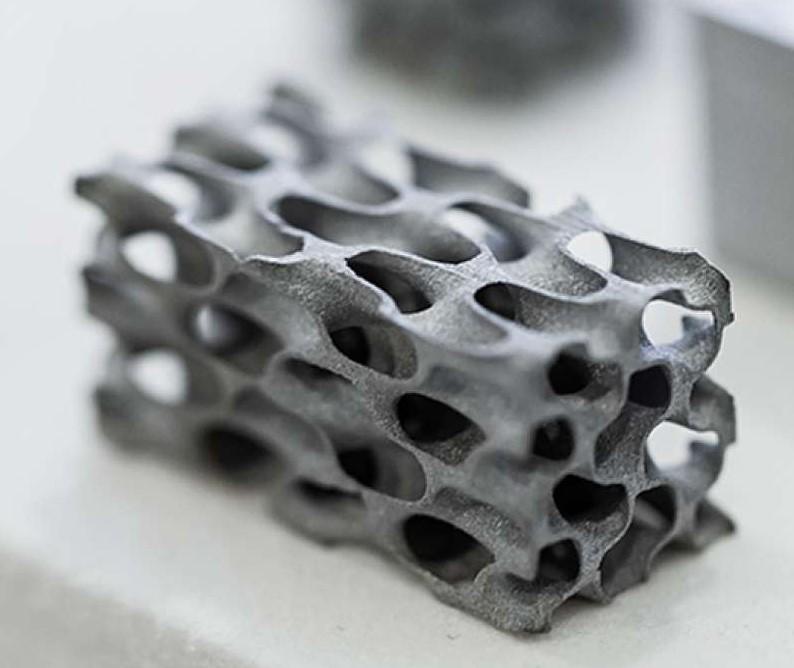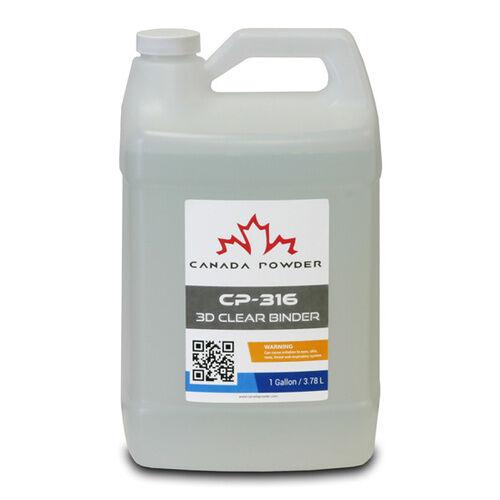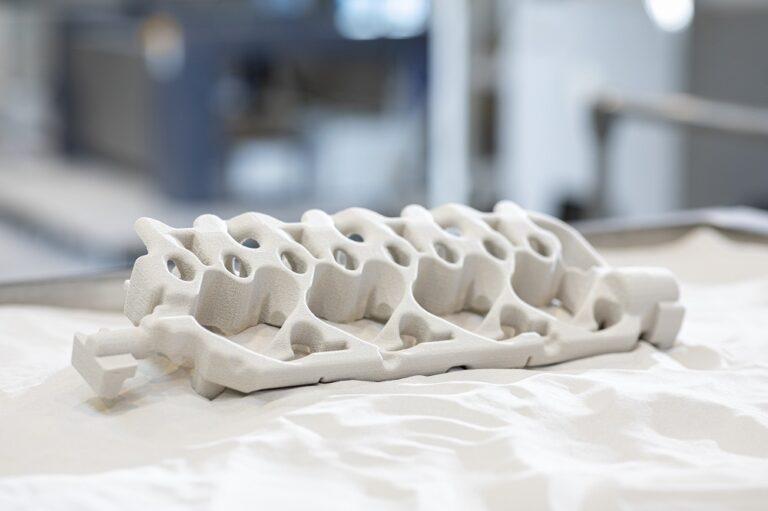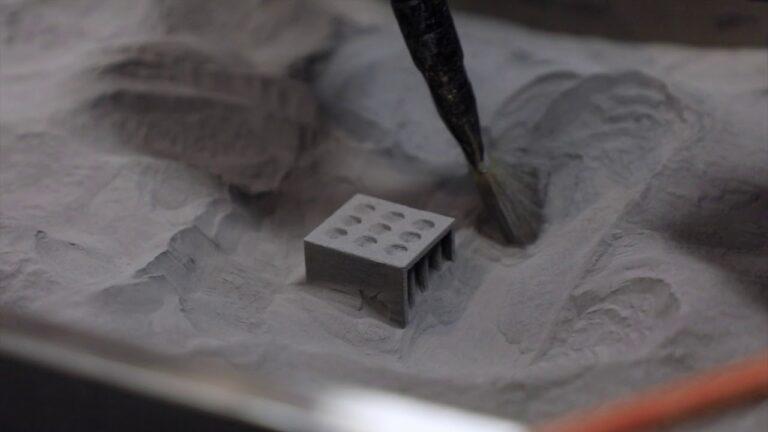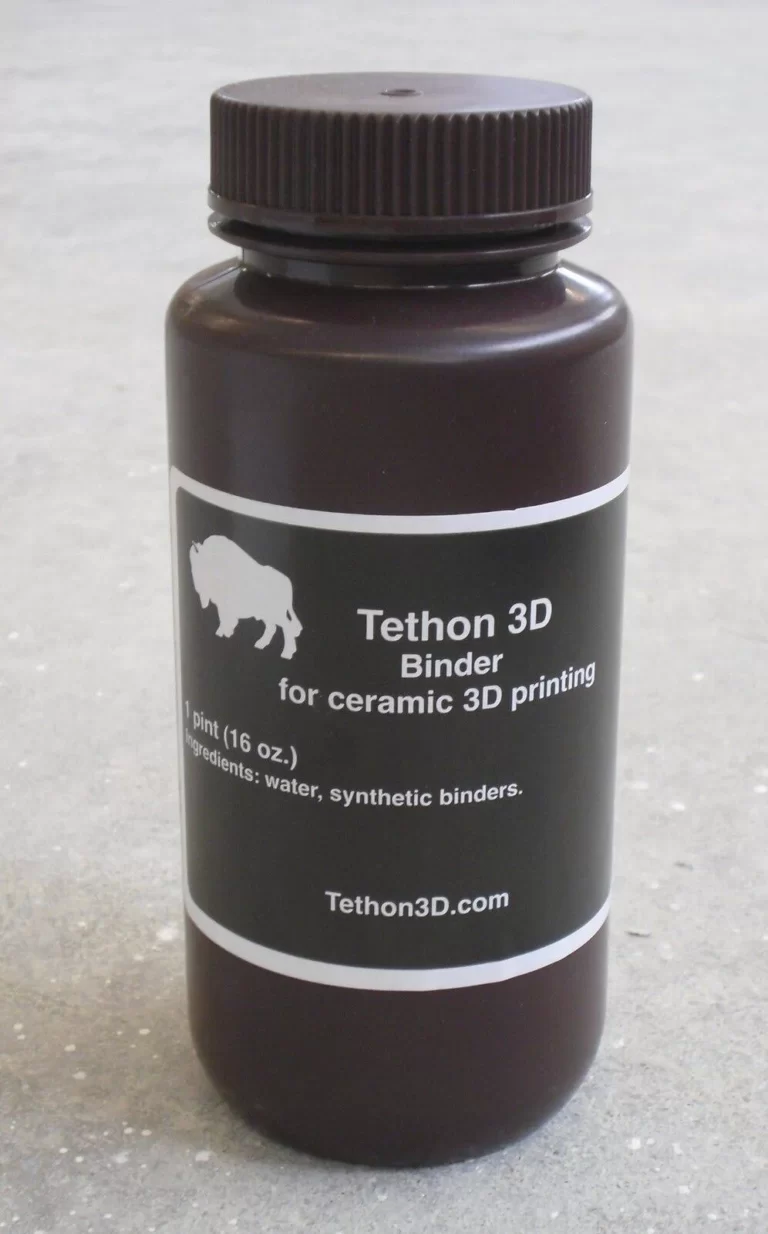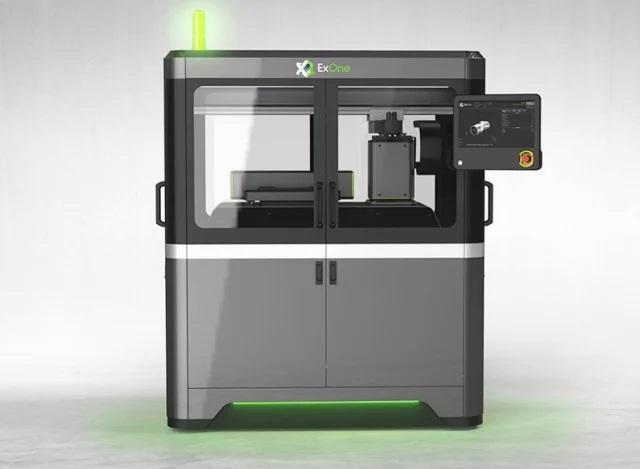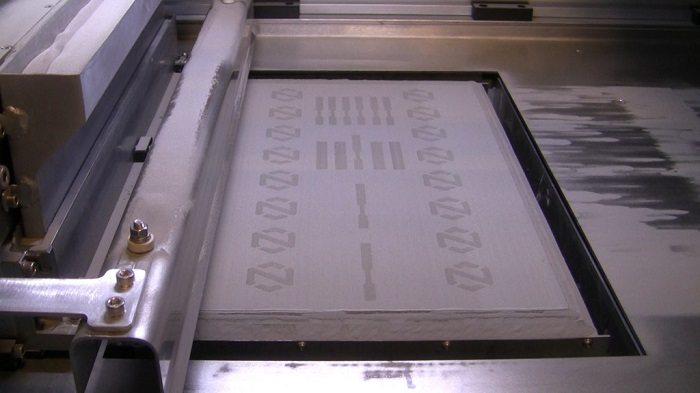Introduction
Metal binder jetting is a type of 3D printing that is gaining popularity in the manufacturing industry due to its unique capabilities. In this process, the printer deposits a liquid binder layer by layer onto a bed of metal powder until it forms a solid object. Once printed, a high-temperature furnace is used to sinter the metal particles together and fuse the object. Metal binder jetting offers a range of benefits, including high resolution and accuracy, material diversity, and cost-effectiveness. This blog explores metal binder jetting basics. Advantages, limitations, and applications in industries. Also, how to design for this process.
Definition of metal binder jetting
Metal binder jetting is a 3D printing method. It uses a powder bed to build parts. A liquid binder is sprayed on the powder. This makes particles stick together. The binder is removed to fuse the metal. This creates a solid part for sintering. In comparison to conventional manufacturing techniques, metal binder jetting is a very precise and effective process. It works with a variety of metals and alloys and enables the creation of complicated geometries. Aerospace, automotive, and medical industries use metal binder jetting. Components have excellent surface finish and resolution. It is a perfect choice.
Metal binder jetting is cost-effective. It’s faster than other techniques. Parts are made in days or hours, not weeks or months. The use of metal binder jetting does have some restrictions, though. Furthermore, metal binder jetting parts might not be appropriate for high-stress applications.
Overall, metal binder jetting is a promising technology with numerous applications in the manufacturing sector. As technology develops and costs come down, metal binder jetting will become more widely used in a variety of applications.
Importance of metal binder jetting in 3D printing
In the world of 3D printing, metal binder jetting is a crucial technology that has several benefits over alternative techniques. Metal binder jetting creates complex shapes with precision, suited for aerospace and medicine. Its accuracy is a key benefit.
Metal binder jetting allows for flexible design and material options. It uses a wide range of metals and alloys. The process is quick and cost-effective. It’s a popular option for businesses seeking manufacturing efficiency.
Metal binder jetting enables greater customization in manufacturing. It allows for designing and producing parts on a smaller scale. This may result in more effective use of materials and resources. It can also create tailored goods for specific uses.
Metal binder jetting is a significant technology that could completely change the manufacturing sector. Metal binder jetting is expanding. It’ll have many applications. Costs will go down. Technology will advance.
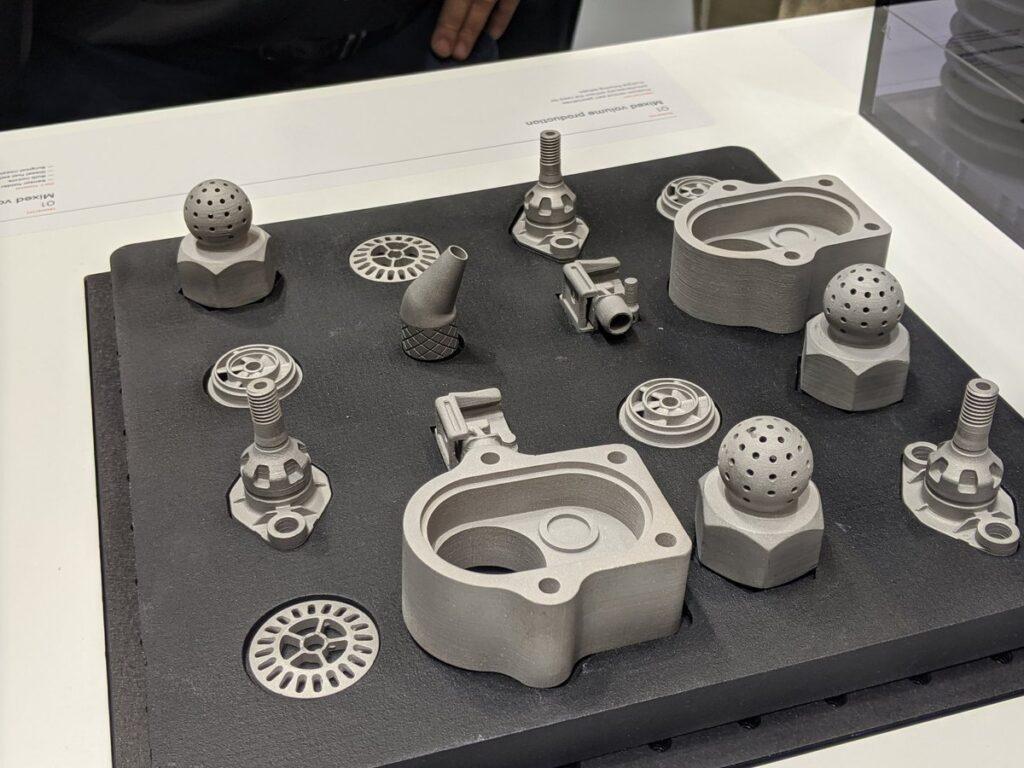
How Metal Binder Jetting Works
Using a bed of metal powder and a liquid binder, metal binder jetting is a 3D printing technique that layers up items. The binder sprays onto the powder bed, which bonds the powder particles and solidifies them. The fused metal particles then create an excellent-quality final product. The method is perfect for a number of applications in sectors like aerospace and automotive since it enables the manufacture of complex geometries with high resolution and accuracy.
Overview of the process
A layer of metal powder is first applied on a build platform before the metal binder jetting procedure starts. Next, the liquid binder selectively jets the powder bed and causes the particles to adhere and form a solid layer. Repeat this procedure for each additional layer until the final part is complete. Finally, fuse the metal particles together to create a high-quality end product. The method is well-known for producing intricate geometries with high precision and accuracy, making it a preferred choice across numerous sectors.
A detailed explanation of each step in the process
The metal binder jetting process involves several steps. First, the printhead selectively jets a liquid binder onto the layer of metal powder spread across a build platform, causing the particles to stick together and form a solid layer.
The printhead selectively jets the binder onto the powder bed according to the desired design for each subsequent layer. They repeat this process for each layer, building up the layers one at a time until the final part is complete.
After the part is fully printed, it is removed from the build platform and undergoes post-processing. This typically involves sintering the part to fuse the metal particles together and create a solid object. The sintering process involves heating the part to a specific temperature for a set amount of time.
Once the sintering process is complete, the part is ready for finishing touches such as polishing or coating. The final product is a high-quality metal part with complex geometries and high resolution, suitable for a wide range of applications in various industries.
Needed equipment
Metal binder jetting requires specialized equipment for the printing process. This includes a build chamber, a printhead for jetting the binder, a recoater blade for spreading the powder, and a heat source for sintering the final part.
The metal powder is spread and the printing process takes place in the building chamber. The printhead selectively jets the binder onto the powder bed, causing the particles to stick together and form a solid layer. The recoater blade evenly spreads the powder across the build platform for each new layer.
The sintering process requires a heat source to fuse the metal particles together and create a solid part. An oven or furnace capable of reaching the required temperature for the specific metal or alloy being used can accomplish this.
Other necessary equipment includes a material handling system for managing the metal powder, as well as software for designing and preparing the 3D model for printing. Overall, metal binder jetting requires a range of specialized equipment to ensure a high-quality final product.
Advantages of Metal Binder Jetting
Compared to conventional manufacturing techniques, metal binder jetting has various advantages. It can create parts using a variety of metal alloys and create complex geometries with excellent resolution and precision.
With little material waste and the capacity to print numerous pieces at once, the procedure is also quite effective. It is also quicker than many other additive printing techniques, making it a desirable choice for small-batch production and rapid prototyping.
Additionally, metal binder jetting enables the production of lightweight components with enhanced internal structures, lowering the final product’s weight and material requirements. It is also possible to use this method for functional prototyping, which enables testing and assessment of the component before committing to large-scale manufacture.
Overall, metal binder jetting has several benefits for a variety of businesses and applications, making it a popular additive manufacturing option.
High resolution and accuracy
Metal binder jetting offers high resolution and accuracy in 3D printing. This is due to the ability to jet the binder selectively onto the powder bed, creating intricate and precise designs. The technology allows for the creation of parts with complex geometries that would be difficult to achieve using other 3D printing methods.
Additionally, the use of metal powder as the raw material allows for a high level of detail and fine features. This results in a final product with a smooth surface finish and minimal post-processing requirements.
Overall, the high resolution and accuracy of metal binder jetting make it a valuable technology for a wide range of industries, including aerospace, medical, and automotive. The ability to create precise and complex parts with ease makes it a highly sought-after 3D printing method.
Large build volumes
Metal binder jetting technology can print objects of a large size, which is referred to as large build volumes. This process enables the printing of large objects that would not be possible with other types of 3D printing. The specific equipment being used determines the size of the build volume, but metal binder jetting has the capability to produce objects up to several feet in size. This makes it ideal for printing large industrial parts and components. With metal binder jetting, companies can create large, complex parts quickly and cost-effectively.
Material diversity
Metal binder jetting can employ metals, ceramics, and composites, among other materials. The diversity of materials makes it possible for various applications and industries to benefit from numerous opportunities. The procedure also makes it possible to produce parts with various degrees of hardness, flexibility, and other characteristics, making it a flexible option for many production requirements.
Cost-effectiveness compared to other metal 3D printing methods
Compared to other metal 3D printing techniques, metal binder jetting is less expensive. The method utilizes less material and prints more quickly, which lowers the cost of production. For small and medium-sized firms wishing to produce metal parts on a budget, this makes it an appealing alternative.
Fast production times
Metal Binder Jetting’s capacity to print numerous components concurrently and with little setup time enables quick production times. A faster turnaround time is achieved by avoiding the requirement for time-consuming post-processing activities.
Limitations of Metal Binder Jetting
When choosing a 3D printing method, one should consider several limitations of Metal Binder Jetting. The lack of material strength compared to traditional metal manufacturing methods is one of the main limitations. The parts produced through Metal Binder Jetting may not be suitable for high-stress applications. Another limitation is the need for post-processing steps to remove the excess binder and sinter the metal particles, which can add to production time and cost. Additionally, Metal Binder Jetting may limit the size and complexity of parts that can be produced due to the size of the print bed and the need for support structures. Finally, the cost of Metal Binder Jetting may be prohibitive for small-scale production, making it more suitable for large-scale production runs.
Size limitations for printed parts
Metal binder jetting has certain size restrictions but may create pieces with complex shapes and exquisite features. The size of the build volume of the printer affects the size of the parts that can be manufactured using this approach. Printing very big components may be difficult because to the necessity for support structures to prevent warping or distortion during printing, even though there are machines with high build volumes. Additionally, the printing time grows as the part size does, which can have an impact on production times and cost-effectiveness. Therefore, when deciding whether to use metal binder jetting for a particular application, it is crucial to take into account the size of the desired part and the capabilities of the printer.
Surface finish limitations
Surface finish limitations can be a challenge when using metal binder jetting technology. The surface quality of the printed parts is highly dependent on the size and distribution of the powder particles used in the process. This can result in a rough or grainy surface finish that may require additional finishing processes. In addition, certain geometries and features may be difficult to print with the required surface finish, which can limit design possibilities. However, advances in metal binder jetting technology are continually improving surface finish capabilities.
Limited use for high-stress applications
Metal binder jetting has limitations when it comes to high-stress applications due to the nature of the process. Parts produced through metal binder jetting tend to have lower density and may be susceptible to cracking or deformation under high loads. This makes it unsuitable for certain high-stress applications where parts need to withstand significant forces or impacts. Additionally, the surface finish of parts produced through metal binder jetting may not be as smooth as those produced through other methods, which can also affect their suitability for high-stress applications. However, for certain applications where strength and durability are not critical factors, metal binder jetting may still be a viable option due to its other advantages such as cost-effectiveness and fast production times.
Applications of Metal Binder Jetting
Metal Binder Jetting technology has a wide range of applications in various industries. It can be used for the production of prototypes, tooling, and end-use parts. The process is ideal for parts that have complex geometries, such as those found in aerospace, automotive, and medical industries.
Metal Binder Jetting is a suitable method in aerospace for producing complex-shaped lightweight parts like brackets, housings, and heat exchangers. Additionally, the technology can be applied to manufacture engine parts and turbine blades.
Metal Binder Jetting enables the automotive industry to produce complex parts like brackets, intake manifolds, and cylinder heads. Moreover, the technology facilitates the production of personalized parts, such as trim pieces and dashboards.
Metal Binder Jetting is a useful technology for producing medical implants and prosthetics with complex geometries in the medical industry. Additionally, it can be employed in the production of surgical instruments and dental appliances.
Overall, Metal Binder Jetting technology has the potential to revolutionize various industries by enabling the production of complex parts with high accuracy, speed, and cost-effectiveness.
Aerospace and aviation
The aerospace and aviation industries can apply Metal Binder Jetting technology to produce lightweight and complex parts with intricate internal structures. For example, NASA has successfully used metal binder jetting to produce rocket engine parts, such as injector components, with shorter lead times and lower costs compared to traditional manufacturing methods. Additionally, metal binder jetting can offer the potential for creating customized parts for individual aircraft and spacecraft, which can result in increased efficiency and improved performance.
Automotive industry
The automotive industry has shown great interest in 3D printing technology in recent years. Metal binder jetting has the potential to produce high-strength, complex parts at a lower cost and faster rate than traditional manufacturing methods. For example, the automotive industry utilizes metal binder jetting to produce tooling and fixtures that can be customized for specific manufacturing processes. Metal binder jetting is also capable of producing lightweight parts with complex geometries for use in vehicles, which can improve fuel efficiency and performance. A real-world example is Volkswagen’s use of metal binder jetting to produce customized fixtures for their manufacturing lines, reducing production time and costs.
Medical industry
The medical industry has been exploring the use of 3D printing for various applications, and metal binder jetting is no exception. The technology enables precise customization of complex metal implants with specific geometries for individual patients. For instance, metal binder jetting has successfully printed dental implants and orthopedic implants, such as hip and knee replacements. Moreover, the technology enables the creation of surgical instruments with intricate designs that traditional manufacturing methods cannot produce. One real-life example is the production of spinal implants using metal binder jetting, which has shown promising results in terms of biocompatibility and functionality.
Jewelry and fashion industry
Metal binder jetting technology is an excellent option for the jewelry and fashion industries because it enables the production of intricate designs and complex geometries. This technology allows the creation of unique objects that were difficult or impossible to manufacture using conventional production techniques. For instance, metal binder jetting can produce limited quantities of bespoke jewelry or personalized rings with elaborate motifs. Additionally, with the aid of this technology, designers can experiment with various materials and forge new alloys, fostering greater industry creativity and innovation. A jewelry designer collaborated with a 3D printing business to create a line of specially manufactured metal jewelry using metal binder jetting technology. This is one real-world instance where the jewelry industry employs this technology.
Prototyping and tooling
Prototyping and tooling refer to the creation of models or molds for product design and manufacturing. Various industries such as automotive, aerospace, and medical use metal binder jetting for prototyping and tooling applications.
In prototyping, metal binder jetting can create high-quality, intricate parts quickly and accurately, allowing for efficient testing and design iterations. Companies can use this technology to produce low-volume parts or small batches of products, which provides a cost-effective solution for product development.
For tooling applications, metal binder jetting can create molds and dies with high precision and complexity. This can improve the efficiency and quality of the manufacturing process, as well as reduce the cost and lead time of tooling production.
One real-world example of metal binder jetting in prototyping and tooling is the production of injection molds for plastic parts in the automotive industry. Metal binder jetting can create complex mold cavities and cores with high accuracy and surface finish, resulting in high-quality plastic parts. This technology can also reduce the cost and time of mold production compared to traditional methods.
Designing for Metal Binder Jetting
Metal Binder Jetting is a powerful 3D printing technology that allows for the creation of complex metal parts with high accuracy and precision. To successfully utilize this technology, it is essential to consider specific design guidelines and limitations that are unique to Metal Binder Jetting. This requires an understanding of the material properties, the printing process, and the software tools available for designing parts. In this section, we will explore the key considerations for designing parts for Metal Binder Jetting and provide guidelines for creating successful prints.
Considerations for part design
When designing for metal binder jetting, it’s important to consider the material properties, tolerances, and geometries that are feasible. Designers should design parts with uniform wall thickness and minimal overhangs to ensure successful printing.
- Avoid thin walls and features that are prone to warping or distortion during sintering.
- Design parts with support structures in mind to prevent deformation or collapse during printing.
- Keep in mind the minimum feature size and tolerances achievable with metal binder jetting.
- Take into account the required surface finish and post-processing steps, such as polishing or coating.
Design guidelines for successful metal binder jetting
To ensure successful metal binder jetting, designers should follow guidelines such as designing for uniform powder spreading, avoiding sharp edges, and incorporating support structures for overhanging features. It’s also important to consider the sintering process and the effects it may have on the final part.
- Optimize designs for the specific material being used and its properties.
- Use lattice structures and hollow features to reduce weight and material usage.
- Choose appropriate support structures and orientations for printing to minimize the need for post-processing.
- Minimize the number of parts needed for assembly by designing parts with interlocking features.
Software and tools for designing with metal binder jetting
Various software and tools are available to aid in designing for metal binder jetting, including CAD programs that can optimize designs for the printing process. Additionally, some companies offer design consulting services to ensure optimal part design and production.
- Use CAD software with dedicated plugins or built-in capabilities for metal binder jetting.
- Use simulation software to optimize designs and predict potential issues during printing and sintering.
- Utilize design guidelines and best practices provided by material and printer manufacturers.
- Consider using generative design techniques to automatically generate optimized designs based on given constraints.
Materials Used in Metal Binder Jetting
Metal binder jetting is a 3D printing technique that is quickly gaining popularity because it enables the creation of metal items with intricate geometries and great accuracy. However, the materials employed have a significant impact on the quality and characteristics of the printed parts. We will give a general review of the materials frequently used in metal binder jetting in this section, along with information on their characteristics, benefits, and drawbacks. For the design and manufacture of metal parts with metal binder jetting to be effective, it is crucial to comprehend the materials employed in this method.
Overview of materials used in metal binder jetting
Using a range of materials, metal binder jetting is a flexible 3D printing technique. Stainless steel, tool steel, and Inconel are some of the metal alloys that are most frequently utilized. Binder jetting can be utilized with ceramics, composites, and other materials in addition to metals.
Common metal alloys used
Due to its strength and resistance to corrosion, stainless steel is a common material choice for metal binder jetting. Another often-used substance with a reputation for hardness and durability is tool steel. Due to its high temperature and corrosion resistance, Inconel is a high-performance superalloy that is frequently employed in aerospace and other industries.
Materials with unique properties
Metal binder jetting can also be utilized with substances that have certain characteristics, including copper and titanium. Titanium is a strong, lightweight material that is frequently utilized in aerospace and medical applications. Copper is the best material for electrical and thermal applications since it is a great conductor of both electricity and heat.
Overall, there are several applications across numerous sectors due to the variety of materials that can be employed in metal binder jetting.
Future of Metal Binder Jetting
Emerging technologies in metal binder jetting are continuously advancing, with research and development focused on improving the speed, precision, and cost-effectiveness of the process. As a result, there is immense potential for metal binder jetting to expand into new industries, such as aerospace, automotive, medical, and jewelry. Additionally, the improvements in speed and cost-effectiveness will make metal binder jetting a more viable option for mass production, rather than just prototyping and low-volume production. With its unique capabilities and continuous advancements, the future of metal binder jetting is bright and full of potential.
Emerging technologies in metal binder jetting
Metal binder jetting technology is constantly evolving and new techniques are being developed to enhance its capabilities. Some of the emerging technologies in metal binder jetting are:
- Multi-material printing: Metal binder jetting is being used to print parts with multiple materials, including metal and ceramic, in a single build process. This enables the creation of parts with unique properties and characteristics.
- In situ sintering: In situ sintering is a process where the green part is sintered during the printing process, eliminating the need for a separate sintering step. This can reduce the time and cost of production.
- High-speed printing: New machines and techniques are being developed to increase the speed of metal binder jetting. This can help to reduce the production time and increase throughput.
- Hybrid printing: Metal binder jetting is being combined with other printing techniques, such as powder bed fusion, to create hybrid printing systems. This can enable the creation of complex parts with unique properties.
These emerging technologies have the potential to revolutionize the capabilities of metal binder jetting and expand its applications in various industries.
Potential applications in new industries
A number of industries could be transformed by metal binder jetting. The method might be used to make light, strong airplane parts, which is one potential application in the aerospace sector. Metal binder jetting has a lot of potential in the medical sector, where it can be utilized to create specialized implants and prosthetics. Metal binder jetting can also help the automotive sector by producing intricate geometries for components that are challenging or impossible to manufacture using conventional manufacturing techniques. The technology can also be utilized to produce delicate and detailed designs for unique pieces in the jewelry and fashion industries.
Improvements in speed and cost-effectiveness
Metal binder jetting is a rapidly advancing technology that is seeing significant improvements in speed and cost-effectiveness. As the technology becomes more refined, production times are decreasing, and costs are coming down, making metal binder jetting more accessible to a wider range of industries. One area of improvement is the ability to print larger parts more quickly, which has been achieved through the development of larger build envelopes and faster printing speeds. Additionally, advancements in materials science and software have led to more efficient and effective part designs, further reducing production time and costs. With continued development and innovation, metal binder jetting has the potential to become a highly competitive manufacturing process for a wide range of industries.
Conclusion
In conclusion, metal binder jetting is a promising technology with a growing presence in various industries. Its ability to produce complex geometries and parts with unique properties makes it a valuable tool in manufacturing. While there are still some limitations to the technology, such as surface finish and dimensional accuracy, ongoing advancements in materials and software are improving the capabilities of metal binder jetting. As the technology continues to evolve, it is expected to find new applications in fields such as aerospace, medical, and automotive industries. The future of metal binder jetting is bright and full of potential, with exciting opportunities for innovation and growth.
Recap of key points about metal binder jetting
Metal binder jetting is a promising technology that enables the creation of complex metal parts in a fast and cost-effective manner. Some key points to remember about this technology include:
- Metal binder jetting involves selectively depositing a binder onto a bed of metal powder to create a green part that is then sintered to produce a solid metal component.
- Part design is an important consideration in metal binder jetting, with certain features such as overhangs and unsupported geometries requiring additional support structures.
- A variety of metal alloys can be used in metal binder jetting, including steel, titanium, and copper, with each alloy having its own unique properties.
- Emerging technologies in metal binder jetting include advancements in binder deposition methods, new materials, and increased automation.
- Metal binder jetting has potential applications in a variety of industries, including aerospace, medical, and automotive.
- Improvements in speed and cost-effectiveness are ongoing goals for metal binder jetting technology.
Overall, metal binder jetting holds great promise for the future of metal manufacturing, with its ability to create complex metal components in a fast and cost-effective manner making it a valuable tool for a wide range of industries.
How do troubleshoot common issues in metal binder jetting?
- Check for powder contamination
If there is an issue with powder sticking to the surface or not binding properly, it could be due to contamination. Check for any impurities or moisture in the powder and make sure it is stored properly in a dry environment.
- Adjust binder saturation levels
If the parts are not bonding together properly or if there are any cracks or gaps, it may be due to improper binder saturation levels. Adjust the levels according to the manufacturer’s guidelines and test again.
- Check for any clogs or blockages in the printhead
If there are any issues with the printer, it could be due to clogs or blockages in the printhead. Check for any debris or build-up and clean it out.
- Verify the correct printing temperature
Make sure that the printing temperature is correct for the type of material being used. Check the manufacturer’s guidelines for the correct temperature range and adjust as necessary.
- Inspect for any damage to the printer or parts
If the parts are not printing correctly or if there are any issues with the printer itself, check for any physical damage or wear and tear. Replace any damaged parts or components as necessary.
- Consult with technical support or the manufacturer
If the above steps do not resolve the issue, contact the manufacturer or technical support for further assistance. Provide as much detail as possible about the issue and the steps you have taken to troubleshoot so they can provide the best possible solution.
FAQs
Metal binder jetting offers several advantages over traditional metal manufacturing methods, including the ability to produce complex geometries, faster production times, and lower costs.
Metal binder jetting can be used with a wide range of metals, including stainless steel, aluminum, copper, bronze, and titanium.
Metal binder jetting is highly accurate, with tolerances as low as 0.1 mm, making it suitable for producing high-precision parts.
Yes, metal binder jetting can be used to produce large-scale metal parts, although the size limitations will vary depending on the specific printer and materials used.
Metal binder jetting parts require post-processing such as sintering to remove the binder and fuse the metal particles together, as well as surface finishing to achieve the desired surface texture and appearance.
Metal binder jetting is being used in a variety of industries, including aerospace, automotive, medical, and industrial manufacturing.
Metal binder jetting is generally more cost-effective than traditional metal manufacturing methods, due to its lower material waste and faster production times. However, the cost will depend on factors such as the specific materials used and the size and complexity of the part.

